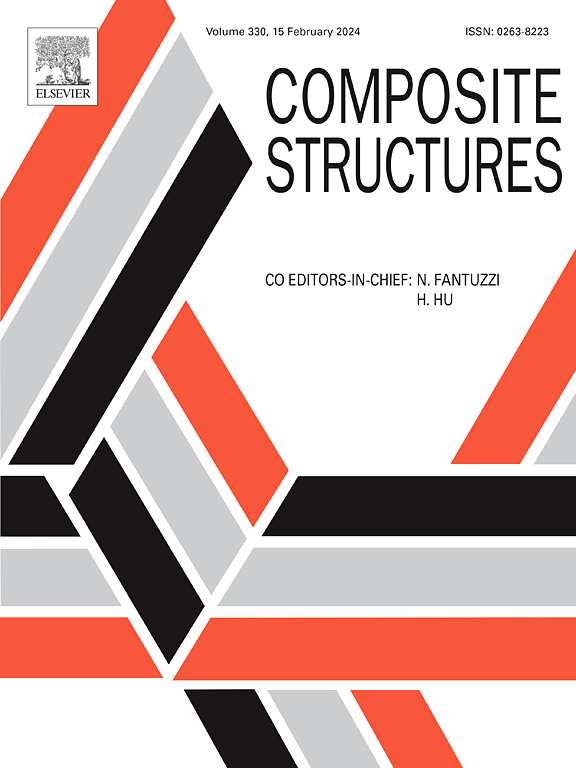考虑温度依赖性晶须断裂和脱键机制的TiB晶须增强钛基复合材料剪切滞后模型
IF 6.3
2区 材料科学
Q1 MATERIALS SCIENCE, COMPOSITES
引用次数: 0
摘要
准确评估晶须对高温强度的贡献对TiB晶须增强钛基复合材料(tmc)的发展至关重要。关键的挑战在于定量表征随温度变化的晶须断裂和界面脱键。本研究通过结合不同破坏模式的微观力学分析来增强剪切滞后模型,并系统地研究了TiBw/TC4 tmc在25-700℃范围内的拉伸破坏行为。实验结果表明,晶须在260℃以下发生断裂,在450℃以上发生脱键,在260℃至450℃之间出现混合失效模式。在650°C时完全失效。增强的模型有效地捕获了这些随温度变化的转变。在500℃以下的断裂和混合破坏区,晶须强化系数为11 ~ 14,强化效率为30 ~ 70 MPa/vol。%被量化,突出了晶须在强化中的重要作用。此外,增加脱键区域的晶须长径比可以保持强化效率,并确定临界断裂长径比是提高性能的最佳晶须尺寸。通过拉伸实验和文献数据验证了模型的准确性和预测能力。该研究提供了一种简单有效的强度预测方法,为高温性能设计和先进复合材料的开发提供了有价值的指导。本文章由计算机程序翻译,如有差异,请以英文原文为准。
An enhanced shear-lag model considering temperature-dependent whisker fracture and de-bonding mechanism for TiB whisker-reinforced titanium matrix composites
Accurately evaluating whisker contributions to high-temperature strength is crucial for advancing TiB whisker-reinforced titanium matrix composites (TMCs). A key challenge lies in quantitatively characterizing temperature-dependent whisker fracture and interfacial de-bonding. This study enhances the shear-lag model by incorporating micromechanical analysis of distinct failure modes and systematically investigates the tensile failure behaviors of TiBw/TC4 TMCs over the temperature range of 25–700 °C. Experimental results reveal a transition from whisker fracture below 260 °C to de bonding above 450 °C, with mixed failure modes observed between 260 °C and 450 °C. Complete failure occurs at 650 °C. The enhanced model effectively captures these transitions with varied temperatures. In fracture and mixed failure regions below 500 °C, whisker strengthening factors of 11 14 and strengthening efficiencies of 30–70 MPa/vol.% were quantified, highlighting the significant role of whiskers in reinforcement. Moreover, increasing the whisker aspect ratio in de-bonding regions preserves strengthening efficiency and identifies critical fracture aspect ratios as the optimal whisker size for performance enhancement. The model’s accuracy and predictive capability are validated against tensile experiments and literature data. This study provides a simple effective method for strength prediction, offering valuable guidance for high-temperature property design and advanced composite development.
求助全文
通过发布文献求助,成功后即可免费获取论文全文。
去求助
来源期刊

Composite Structures
工程技术-材料科学:复合
CiteScore
12.00
自引率
12.70%
发文量
1246
审稿时长
78 days
期刊介绍:
The past few decades have seen outstanding advances in the use of composite materials in structural applications. There can be little doubt that, within engineering circles, composites have revolutionised traditional design concepts and made possible an unparalleled range of new and exciting possibilities as viable materials for construction. Composite Structures, an International Journal, disseminates knowledge between users, manufacturers, designers and researchers involved in structures or structural components manufactured using composite materials.
The journal publishes papers which contribute to knowledge in the use of composite materials in engineering structures. Papers deal with design, research and development studies, experimental investigations, theoretical analysis and fabrication techniques relevant to the application of composites in load-bearing components for assemblies, ranging from individual components such as plates and shells to complete composite structures.
 求助内容:
求助内容: 应助结果提醒方式:
应助结果提醒方式:


